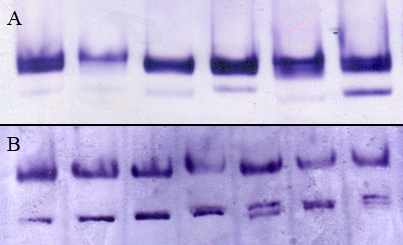Isozyme variants in two natural populations of Lymnaea luteola
Abstract
Lymnaea luteola is a fresh water gastropod snail, inhabiting ponds and lakes of different parts of India. Two populations of L. luteola were collected from fresh water ponds of district Varanasi (Uttar Pradesh) and analysed for their isozyme variants of Xanthine dehydrogenase (Xdh) and Aldehyde oxidase (Ao) enzymes loci. Both enzymes were found to be represented by two distinct loci and each locus of an enzyme showed polymorphic appearance. Based on the electrophoretic variant data, level of heterozygosity was computed for each enzyme locus. Our analysis clearly reveals that L. luteola inhabiting in these two ponds have undergone enough genetic differentiation.
Downloads
References
2. Singh AK, Kumar S, Ratnam D. Genetic differentiation in natural populations and their mass culture stocks of Drosophila ananassae. Thai J Genetics. 2014; 7: 123-132.
3. Kumar S, Singh AK. Electrophoretic variants of xanthine dehydrogenase enzyme in natural populations of Drosophila ananassae. Dros Inf Serv. 2012; 95: 18-20.
4. Kumar S, Singh AK. Complete absence of linkage disequilibrium between enzyme loci in natural populations of Drosophila ananassae. Genetika. 2014; 46: 227-234.
5. Kumar S, Singh AK. Latitudinal clines of allozymes in Indian natural populations of Drosophila ananassae. Dros Inf Serv. 2014; 97: 63-67.
6. Kumar S, Singh AK. Allozyme polymorphism in Drosophila. Proc Zool Soc. 2016; 69: 22-31.
7. Kumar S, Singh AK. Population genetics of Drosophhila: genetic variation and differentiation among Indian natural populations of Drosophila ananassae. Zool Stud. 2017; 56: 1-10.
8. Singh G, Singh AK. Electrophoretic variants of xanthine dehydrogense enzyme in Drosophila malerkotliana. Dros Inf Serv. 2016; 99: 35-36.
9. Krishnamoorti K, Singh AK. Fitness differences due to allelic variation at esterase-4 locus in Drosophila ananassae. J Genet. 2017; 96: 625-631.
10. Presgraves DC. The molecular evolutionary basis of species formation. Nat Rev Genet. 2010; 11: 175-180.
11. Singh AK, Kumar S, Singh N. Detecting level of genetic differentiation in two closely related species of Drosophila: D. bipectinata and D. malerkotliana. Genetika. 2016; 48: 963-970.
12. Harris H. Enzyme polymorphism in man. Proc Roy Soc Lond B Biol Sci. 1966; 164, 298-310.
13. Lewontin, RC, Hubby JL. A molecular approach to the study of genic heterozygosity in natural populations, II. Amount of variation and degree of heterozygosity in natural populations of Drosophila pseudoobscura. Genetics. 1966; 54: 595-609.
14. Harris H, Hopkinson DA. Handbook of enzyme electrophoresis in human genetics. North Holland publishing Co. Amsterdam. 1976.
15. Pinsker W, Sperlich D. Allozyme variation in natural populations of Drosophila subobscura along a North-South gradient. Genetica. 1979; 50: 207- 219.
16. Arnalud JF, Madec L, Guiller A, Bellido A. Spatial analysis of allozyme and microsatellite DNA polymorphisms in the land snail Helix aspersa (Gastropoda: Helicidae). Mol Ecol. 2001; 10(6): 1563-1576.
17. Davison A, Chiba S, Barton HN, Clarke B. Speciation and gene flow between snails of opposite chirality. PLOS Biol. 2005; 3: 1559-1571.
18. Janson K. Allozyme and shell variation in two marine snails (Littorinu, Prosobranchia) with different dispersal abilities. Biol J Linnean Soc. 1987; 11: 245-256.
19. Levan G, Fredga K. Isozyme polymorphism in three species of land snails. Hereditas. 1972; 71: 245-252.
20. Das S, Khangarot BS. Bioaccumulation of copper and toxic effects on feeding, growth, fecundity and development of pond snail Lymnaea luteola L. J Hazard Mater. 2011; 185: 295-303.
21. Das S, Khangarot BS. Bioaccumulation and toxic effects of cadmium on feeding and growth of an Indian pond snail Lymnaea luteola L. under laboratory conditions. J Hazard Mater. 2010; 182: 763-770.
22. Kakar S, Kashif K, Essote SA, Asim I, Muhammad A. Species diversity of freshwater snails (Mollusca: Gastropoda) in different sites of Balochistan province of Pakistan. Int J Biosci. 2017; 10: 251-259.
23. Gittenberger E. Sympatric speciation in snail: a largely neglected model. Evolution. 1988; 42: 826-828.
24. Subba RNV. Freshwater molluscs of India. Zoological Survey of India, Culcutta. 1989.
25. Ramakrishna, Dey A. Handbook on Indian freshwater molluscs. Zoological Survey of India, Kolkata, 2007.
26. Ayala FJ, Powell JR, Tracey ML, Mourao CA, Pérez-Salas S. Enzyme variability in Drosophila willstoni group IV. Genetic variation in natural population in Drosophila willstoni. Genetics. 1972; 70: 113-139.
27. Triggs SJ, Sherley GH. Allozyme genetic diversity in Placostylus land snails and implications for conservation. New Zealand J Zool. 1993; 20(1): 19-33.
28. Jordaens K, Backeljau T, Ondina P, Reise H, Verhagen R. Allozyme homozygosity and phally polymorphism in the land snail Zonitoides nitidus (Gastropoda, Pulmonata). J Zool Lond. 1998; 246: 95-104.
29. Carvalho OS, Cardoso PCM, Pollanah ML, Rumi A, Roche A, Berne E, et al. The use of the polymerase chain reaction and restriction fragment length polymorphism technique associated with the classical morphology for characterization of Lymnaea columella, L. viatrix, and L. diaphana (Mollusca: Lymnaeidae) Mem Inst Oswaldo Cruz Rio de Janeiro. 2004; 99: 503-507.
30. de Boer PACM, Jansen RF, ter Maat A. Copulation in the hermaphrodite snail Lymnaea stagnalis. Invertebr Reprod Dev. 1996; 30: 167-176.


This work is licensed under a Creative Commons Attribution-NonCommercial 4.0 International License.




